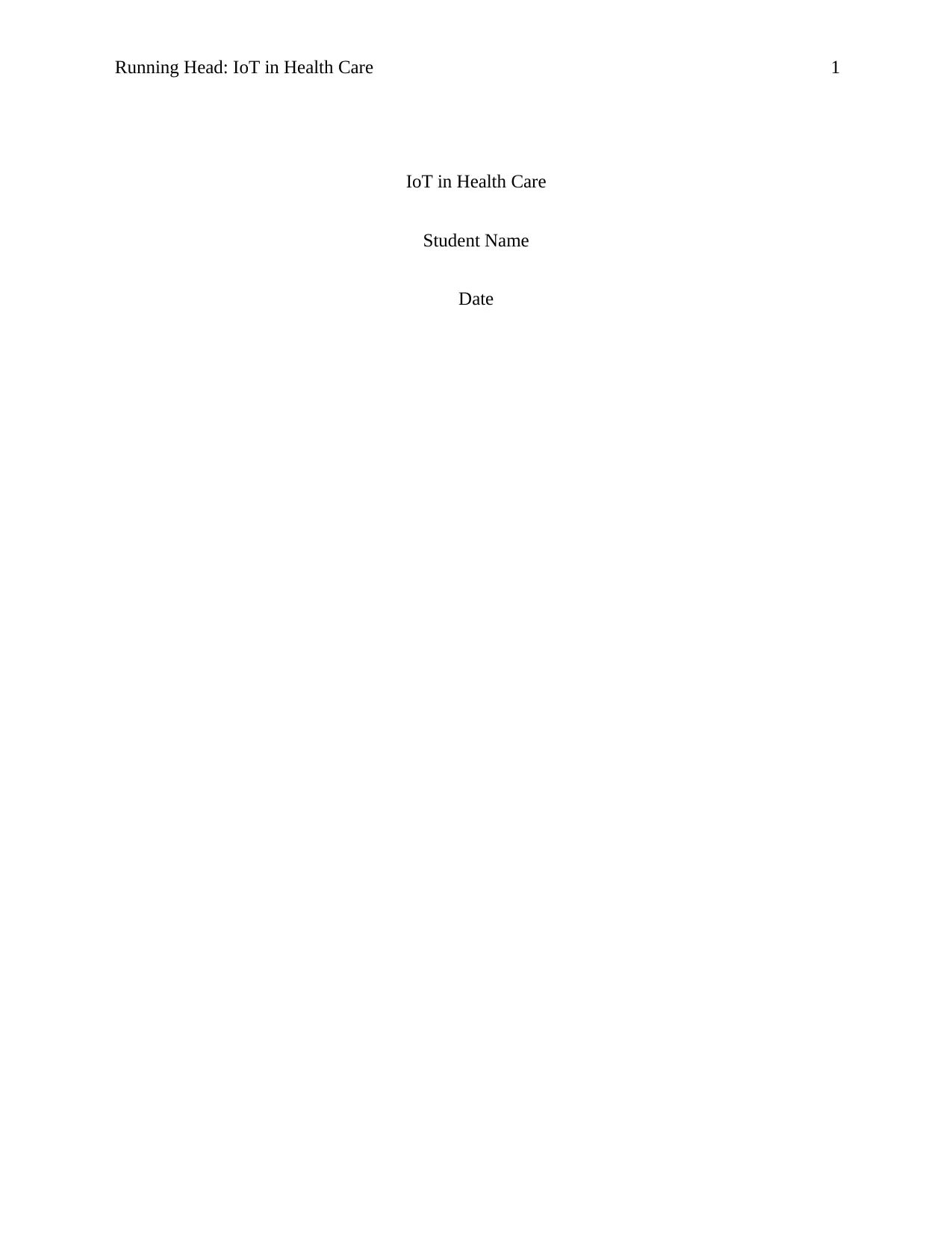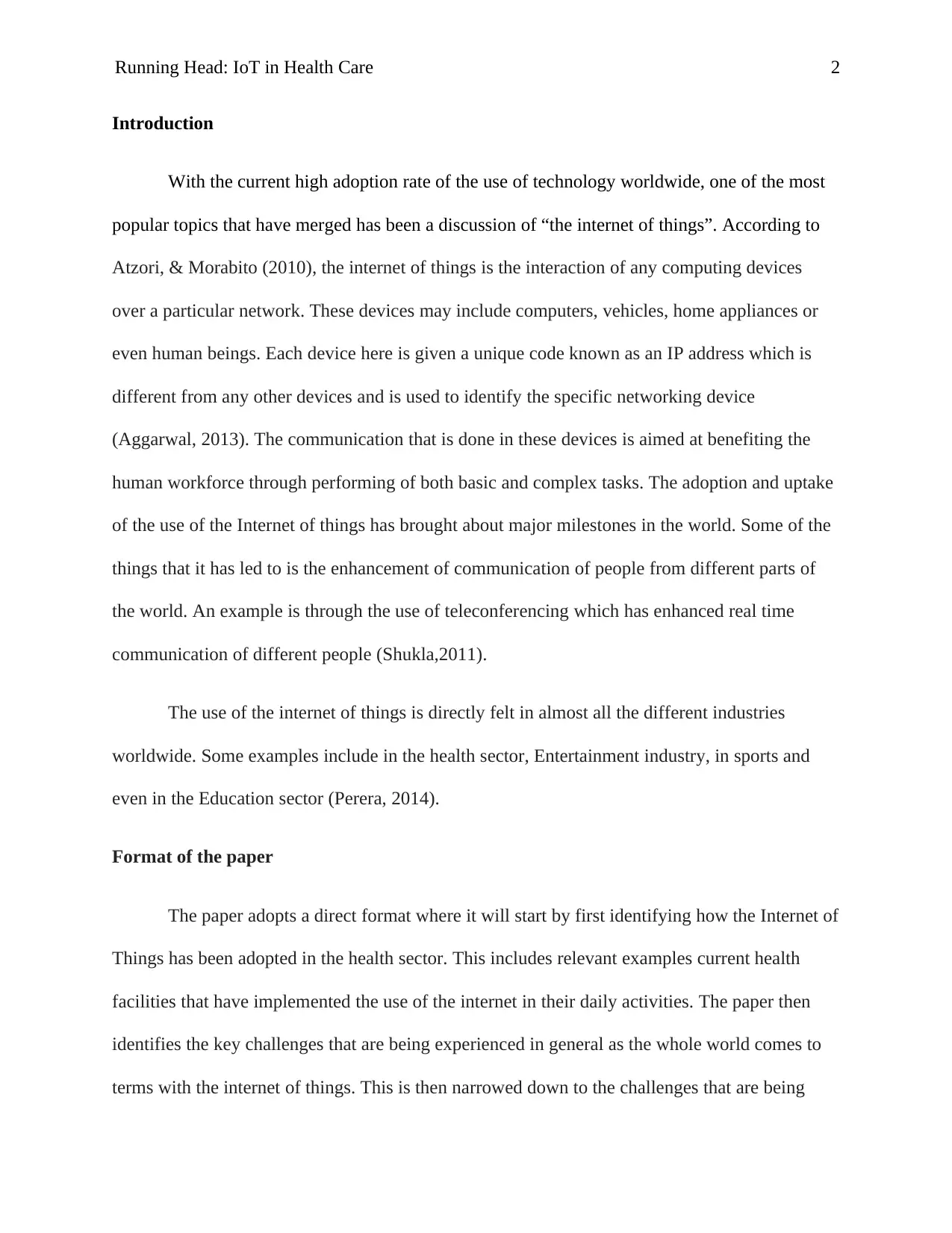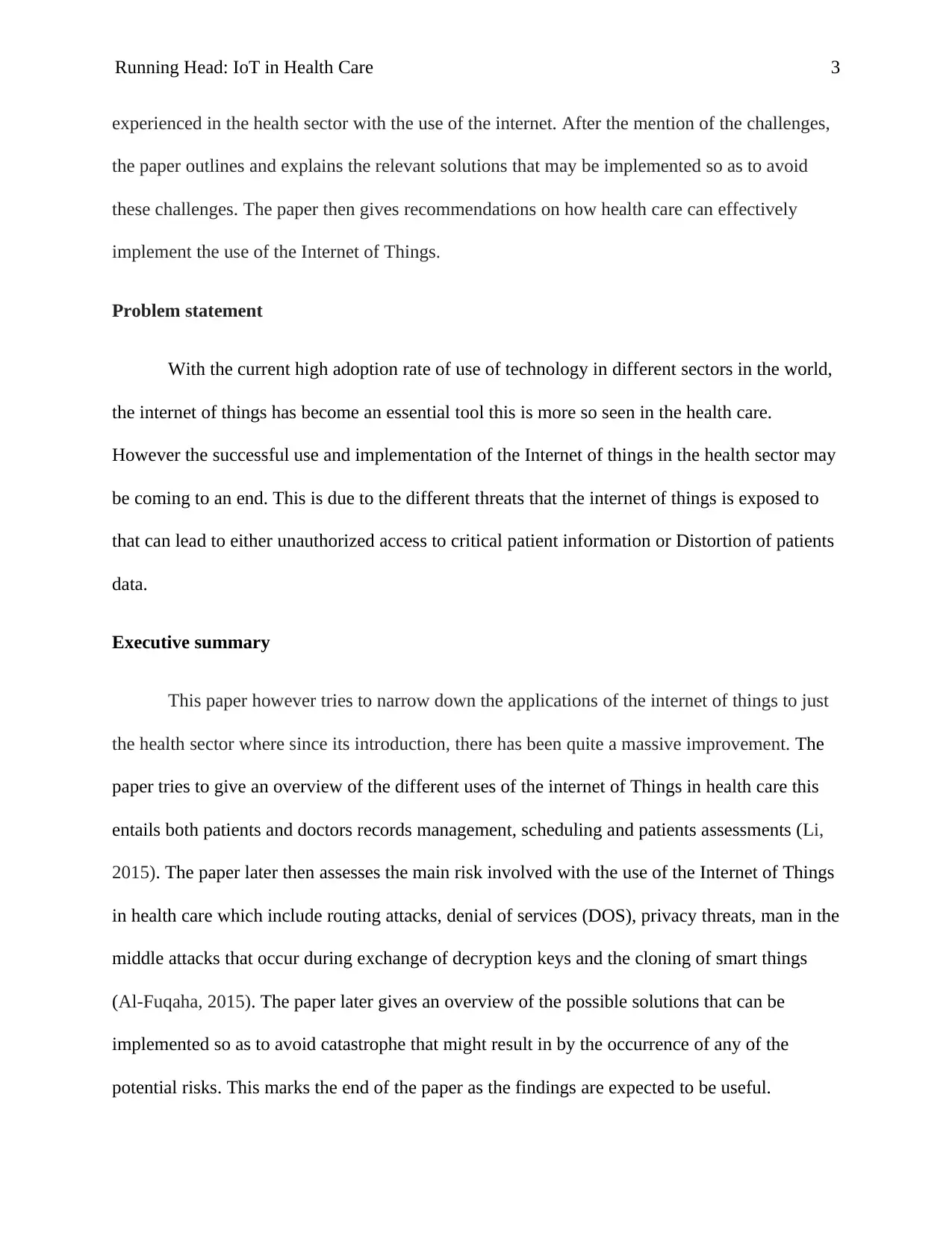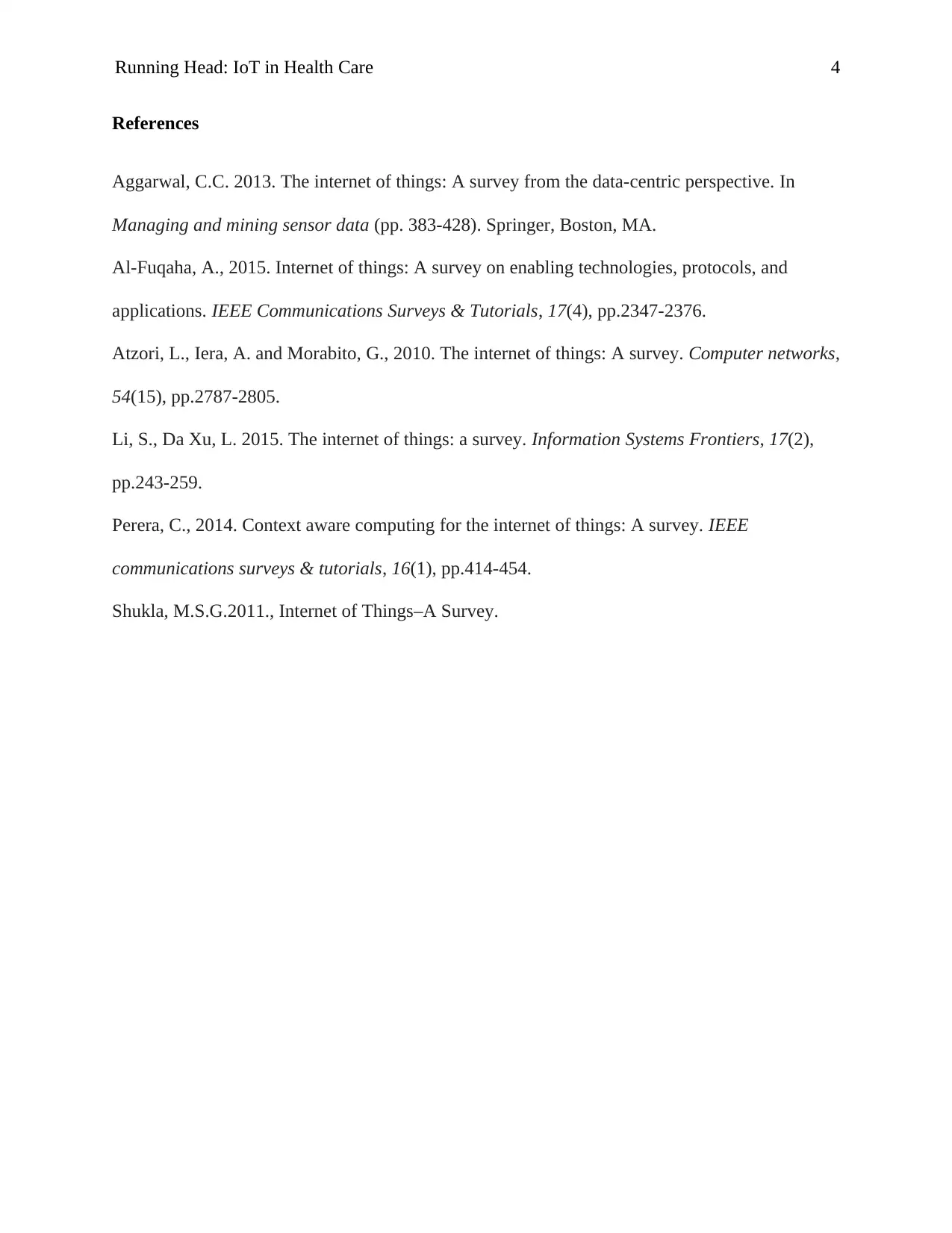Comprehensive Report on IoT in Healthcare: Risks and Solutions
VerifiedAdded on 2023/06/13
|4
|871
|472
Report
AI Summary
This paper examines the applications of the Internet of Things (IoT) within the healthcare sector, highlighting the improvements in patient and doctor record management, scheduling, and patient assessments. It assesses the risks involved with IoT in healthcare, including routing attacks, denial of service (DOS), privacy threats, man-in-the-middle attacks, and cloning of smart devices. The report provides an overview of possible solutions to mitigate these risks and protect patient data, aiming to offer useful insights for the effective and secure implementation of IoT in healthcare.

Running Head: IoT in Health Care 1
IoT in Health Care
Student Name
Date
IoT in Health Care
Student Name
Date
Paraphrase This Document
Need a fresh take? Get an instant paraphrase of this document with our AI Paraphraser

Running Head: IoT in Health Care 2
Introduction
With the current high adoption rate of the use of technology worldwide, one of the most
popular topics that have merged has been a discussion of “the internet of things”. According to
Atzori, & Morabito (2010), the internet of things is the interaction of any computing devices
over a particular network. These devices may include computers, vehicles, home appliances or
even human beings. Each device here is given a unique code known as an IP address which is
different from any other devices and is used to identify the specific networking device
(Aggarwal, 2013). The communication that is done in these devices is aimed at benefiting the
human workforce through performing of both basic and complex tasks. The adoption and uptake
of the use of the Internet of things has brought about major milestones in the world. Some of the
things that it has led to is the enhancement of communication of people from different parts of
the world. An example is through the use of teleconferencing which has enhanced real time
communication of different people (Shukla,2011).
The use of the internet of things is directly felt in almost all the different industries
worldwide. Some examples include in the health sector, Entertainment industry, in sports and
even in the Education sector (Perera, 2014).
Format of the paper
The paper adopts a direct format where it will start by first identifying how the Internet of
Things has been adopted in the health sector. This includes relevant examples current health
facilities that have implemented the use of the internet in their daily activities. The paper then
identifies the key challenges that are being experienced in general as the whole world comes to
terms with the internet of things. This is then narrowed down to the challenges that are being
Introduction
With the current high adoption rate of the use of technology worldwide, one of the most
popular topics that have merged has been a discussion of “the internet of things”. According to
Atzori, & Morabito (2010), the internet of things is the interaction of any computing devices
over a particular network. These devices may include computers, vehicles, home appliances or
even human beings. Each device here is given a unique code known as an IP address which is
different from any other devices and is used to identify the specific networking device
(Aggarwal, 2013). The communication that is done in these devices is aimed at benefiting the
human workforce through performing of both basic and complex tasks. The adoption and uptake
of the use of the Internet of things has brought about major milestones in the world. Some of the
things that it has led to is the enhancement of communication of people from different parts of
the world. An example is through the use of teleconferencing which has enhanced real time
communication of different people (Shukla,2011).
The use of the internet of things is directly felt in almost all the different industries
worldwide. Some examples include in the health sector, Entertainment industry, in sports and
even in the Education sector (Perera, 2014).
Format of the paper
The paper adopts a direct format where it will start by first identifying how the Internet of
Things has been adopted in the health sector. This includes relevant examples current health
facilities that have implemented the use of the internet in their daily activities. The paper then
identifies the key challenges that are being experienced in general as the whole world comes to
terms with the internet of things. This is then narrowed down to the challenges that are being

Running Head: IoT in Health Care 3
experienced in the health sector with the use of the internet. After the mention of the challenges,
the paper outlines and explains the relevant solutions that may be implemented so as to avoid
these challenges. The paper then gives recommendations on how health care can effectively
implement the use of the Internet of Things.
Problem statement
With the current high adoption rate of use of technology in different sectors in the world,
the internet of things has become an essential tool this is more so seen in the health care.
However the successful use and implementation of the Internet of things in the health sector may
be coming to an end. This is due to the different threats that the internet of things is exposed to
that can lead to either unauthorized access to critical patient information or Distortion of patients
data.
Executive summary
This paper however tries to narrow down the applications of the internet of things to just
the health sector where since its introduction, there has been quite a massive improvement. The
paper tries to give an overview of the different uses of the internet of Things in health care this
entails both patients and doctors records management, scheduling and patients assessments (Li,
2015). The paper later then assesses the main risk involved with the use of the Internet of Things
in health care which include routing attacks, denial of services (DOS), privacy threats, man in the
middle attacks that occur during exchange of decryption keys and the cloning of smart things
(Al-Fuqaha, 2015). The paper later gives an overview of the possible solutions that can be
implemented so as to avoid catastrophe that might result in by the occurrence of any of the
potential risks. This marks the end of the paper as the findings are expected to be useful.
experienced in the health sector with the use of the internet. After the mention of the challenges,
the paper outlines and explains the relevant solutions that may be implemented so as to avoid
these challenges. The paper then gives recommendations on how health care can effectively
implement the use of the Internet of Things.
Problem statement
With the current high adoption rate of use of technology in different sectors in the world,
the internet of things has become an essential tool this is more so seen in the health care.
However the successful use and implementation of the Internet of things in the health sector may
be coming to an end. This is due to the different threats that the internet of things is exposed to
that can lead to either unauthorized access to critical patient information or Distortion of patients
data.
Executive summary
This paper however tries to narrow down the applications of the internet of things to just
the health sector where since its introduction, there has been quite a massive improvement. The
paper tries to give an overview of the different uses of the internet of Things in health care this
entails both patients and doctors records management, scheduling and patients assessments (Li,
2015). The paper later then assesses the main risk involved with the use of the Internet of Things
in health care which include routing attacks, denial of services (DOS), privacy threats, man in the
middle attacks that occur during exchange of decryption keys and the cloning of smart things
(Al-Fuqaha, 2015). The paper later gives an overview of the possible solutions that can be
implemented so as to avoid catastrophe that might result in by the occurrence of any of the
potential risks. This marks the end of the paper as the findings are expected to be useful.
⊘ This is a preview!⊘
Do you want full access?
Subscribe today to unlock all pages.

Trusted by 1+ million students worldwide

Running Head: IoT in Health Care 4
References
Aggarwal, C.C. 2013. The internet of things: A survey from the data-centric perspective. In
Managing and mining sensor data (pp. 383-428). Springer, Boston, MA.
Al-Fuqaha, A., 2015. Internet of things: A survey on enabling technologies, protocols, and
applications. IEEE Communications Surveys & Tutorials, 17(4), pp.2347-2376.
Atzori, L., Iera, A. and Morabito, G., 2010. The internet of things: A survey. Computer networks,
54(15), pp.2787-2805.
Li, S., Da Xu, L. 2015. The internet of things: a survey. Information Systems Frontiers, 17(2),
pp.243-259.
Perera, C., 2014. Context aware computing for the internet of things: A survey. IEEE
communications surveys & tutorials, 16(1), pp.414-454.
Shukla, M.S.G.2011., Internet of Things–A Survey.
References
Aggarwal, C.C. 2013. The internet of things: A survey from the data-centric perspective. In
Managing and mining sensor data (pp. 383-428). Springer, Boston, MA.
Al-Fuqaha, A., 2015. Internet of things: A survey on enabling technologies, protocols, and
applications. IEEE Communications Surveys & Tutorials, 17(4), pp.2347-2376.
Atzori, L., Iera, A. and Morabito, G., 2010. The internet of things: A survey. Computer networks,
54(15), pp.2787-2805.
Li, S., Da Xu, L. 2015. The internet of things: a survey. Information Systems Frontiers, 17(2),
pp.243-259.
Perera, C., 2014. Context aware computing for the internet of things: A survey. IEEE
communications surveys & tutorials, 16(1), pp.414-454.
Shukla, M.S.G.2011., Internet of Things–A Survey.
1 out of 4
Related Documents
Your All-in-One AI-Powered Toolkit for Academic Success.
+13062052269
info@desklib.com
Available 24*7 on WhatsApp / Email
![[object Object]](/_next/static/media/star-bottom.7253800d.svg)
Unlock your academic potential
Copyright © 2020–2025 A2Z Services. All Rights Reserved. Developed and managed by ZUCOL.




